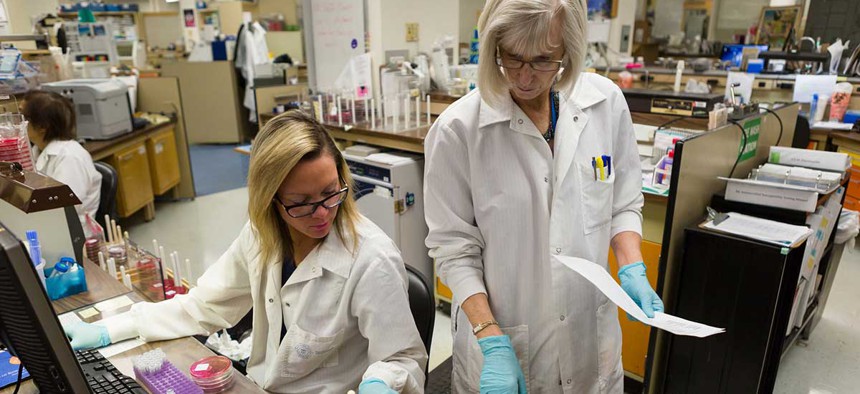
Technicians review test results in the Clinical Center’s Department of Laboratory Medicine in 2015. NIH file photo
All the Ways Trump’s Budget Cuts Science Funding
From the EPA, to the NIH, and NASA, research is not a priority in the administration’s fiscal blueprint.
President Trump’s budget blueprint , released Thursday morning, is supposed to lay out the administration priorities, and science is clearly not among them. It deals sweeping cuts to science and health agency budgets, and, in some cases, targets specific programs championed by the Obama administration.
The administration will release a more detailed budget request later this year, and Congress will ultimately have to approve the federal budget. But in this opening bid, there is not much good news for scientists. “This would be pretty devastating to the American science and technology enterprise,” said Matt Hourihan, director of the American Association for the Advancement of Science’s R&D Budget and Policy Program.
The National Institutes of Health, for example, gets a budget cut of 18 percent to $25.9 billion. The NIH funds much of the disease research at universities and hospitals and carries out its own research programs.
The blueprint calls for a “major reorganization” of the NIH’s 27 institutes and centers. One cancer researcher told Nature they were especially worried about funding for multi-year epidemiology studies at the NIH’s cancer institute, where even short interruptions can hinder a study. And in keeping with the cuts to diplomacy in the overall budget , the one center named for complete elimination is the Fogarty International Center, whose mission is global health.
How the budget will affect the Centers for Disease Control and Prevention is less clear. The blueprint asks to reform the CDC through a $500 million block-grant program, that will allow each state to decide how best to use the money. Notably, perhaps, given that epidemics are international in nature , it does not mention anything about funding the CDC’s global work.
In the Department of Energy, nuclear weapons spending gets a boost to the detriment of renewable energy. The budget would eliminate Advanced Research Projects Agency-Energy (ARPA-E), which has given out $1.5 billion to 580 high-risk, high-reward projects in renewable energy and efficiency since 2009. Loan programs for clean energy projects and fuel-efficient cars are also on the chopping block.
In addition, the blueprint cuts $900 million from the Office of Science, which runs ten of the DOE’s seventeen national laboratories. The laboratories carry out a wide range of research, from sequencing for the original Human Genome Project to current fusion energy research.
The Environmental Protection Agency is, unsurprisingly given everything Trump said during the campaign, the biggest target. The blueprint lays out the EPA’s budget as $5.7 billion, effectively a 31 percent cut. It will eliminate the Clean Power Plan, President Obama’s flagship policy for lowering carbon emissions.
But that’s not all. The budget eliminates a full 50 programs the administration deems “lower priority and poorly performing,” including Energy Star (which sets standards for energy-efficient household appliances) and the Endocrine Disruptor Screening Program (which addresses chemicals like BPA). The Superfund program will get 30 percent less funding for cleanup of hazardous waste sites.
Earth science will also lose major funding resources from National Oceanic and Atmospheric Administration and NASA. The plan eliminates $250 million in funding for NOAA, which would cut grants supporting coastal and ocean research. It also cuts $102 million from NASA’s Earth science program and ends four missions that would have observed the Earth from space: PACE, OCO-3, DSCOVR Earth-viewing instruments, and CLARREO Pathfinder.
The Trump administration wants NASA to refocus on space exploration, but first, it wants to kill the Asteroid Redirect Mission, where astronauts would have plucked a rock from space and tugged it into lunar orbit. The mission has never been particularly popular, though the Obama administration sold it as a stepping stone to Mars. What the budget does endorse are the Orion crew vehicle and Space Launch System, which are supposed to eventually take astronauts into Mars and deep space. It also endorses a flyby mission to Europa and a Mars rover. Overall NASA only gets a 0.8 percent budget decrease but it comes with a massive reallocation of resources.
The National Science Foundation, which gives $7 billion a year in grants to universities and research institutes, is not specifically mentioned in the budget. Unspecified “other agencies” are in line for a 9.8 percent budget cut according to the blueprint.
In Trump’s overall budget, defense spending is the bigger winner with an increase of $52 billion. The blueprint does not mention funding for military science research programs, such as DARPA. It’s too soon to say whether that might be the one area where science gets a boost.






